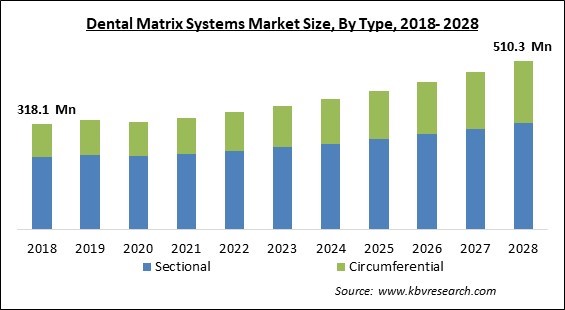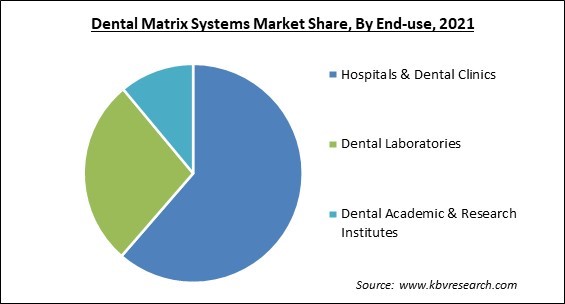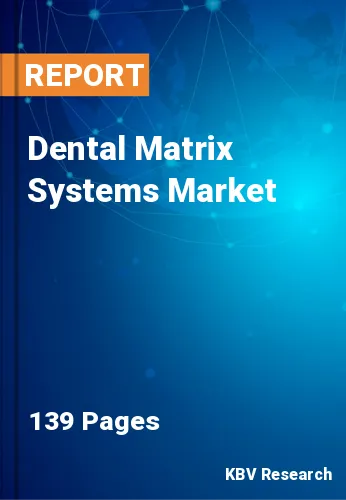The Global Dental Matrix Systems Market size is expected to reach $510.3 million by 2028, rising at a market growth of 6.2% CAGR during the forecast period.
The interproximal contact and natural tooth form are recreated, the gingival walls or proximal of the prep are sealed, and the thickness of the matrix band is addressed using a dental matrix system. The purpose of dental matrix systems is to provide a temporarily interproximal wall of a tooth surface during the restoration procedure.

Dental exams and visits on a regular basis may increase demand for dental treatments and operations. As per the Centers for Disease Control and Prevention (CDC), over 84.9 percent of children aged 2 to 17 years, approximately 64.0 percent of adults aged 18 to 64 years, and nearly 65.6 percent of individuals aged 65 and more have visited a dentist at least once. Crowns, bonding treatments, maxillofacial procedures, root canals, and fillings are among the most common procedures performed during routine exams. As a result, regular dental checks are anticipated to drive the market growth.
Some include V-shaped silicone tines that are soft enough to hug anatomy while exerting sufficient equal force on tooth surfaces to keep debris contained and teeth separated. Because the adjacent tooth that was forced out of the way will assume its original position against the freshly restored tooth once the ring is removed, this promotes tight interproximal interactions. Rings are commonly constructed of nickel titanium and can be stacked for work on big MOD restorations or numerous restorations at the same time. Some even have clear tines to make light curing easier.
The COVID-19 has had an impact on all markets, including the medical business, because the government has imposed a nationwide lockdown. The pandemic has produced a considerable disruption in the supply chain of the broader medical device industry. The manufacturing units were all closed to curb the spread of the virus. On the other hand, the healthcare activities were shifted to majorly focus on COVID patients, over other non-critical patients. This has negatively impacted the demand and growth of the dental matrix systems market.
There is an increase in the cases of dental problems among people across the world. The majority of oral health problems are essentially avoidable and treatable in their initial phases. Dental caries (tooth decay), oral malignancies, periodontal diseases, oro-dental injuries, cleft lip and palate, and noma are the most common conditions. Due to this, the demand for various dental problems and procedures would increase in the market. Anatomical differences do not influence the function of the organ in normal circumstances. Clinically, however, anatomical variances play an essential part in diagnosis and therapeutic processes, necessitating extra attention or special setups.
With the advancement in technology and improvement in the standards, companies across this dental matrix systems market are increasingly investing in R&D activities for advanced products and solutions. Along with that, governments across various nations are supporting their healthcare sector with greater investment and are compelling healthcare institutions to introduce better products and procedures. Also, key market players are launching more products in the market. Anatomical variances are identified in part by practitioners and anatomical scientists. Traditionally, cadaveric dissection was the method of choice for discovering anatomical differences.
There is a high cost associated with the surgical process done by the doctors in order to use dental matrix systems for correcting teeth deformity. Along with that, many people do not take dental problems seriously and hence, they do not consult a doctor for any kind of problem they face. Due to this negligence behavior among people regarding oral health, the demand for various dental procedures and solution has hampered across the globe. In addition, the dearth of awareness among people regarding the importance of maintaining oral health would significantly impact the market.

Based on type, the dental matrix systems market is divided into Circumferential Matrix Systems and Sectional Matrix Systems. Sectional Matrix Systems segment acquired the highest revenue share in the dental matrix systems market in 2021. This is because sectional matrix approaches provide more consistent contact areas. In Class II composite resin restorations in the posterior sector, the sectional matrix is the most widely used method of creating a strong contact point. Each tooth in the sectional matrix system is divided into separate segments by a matrix band that can be disconnected in the same way that rubber bands can be detached.
By end-use, the dental matrix systems market is segmented into Hospitals and Dental Clinics, Dental Laboratories, and Dental Academic and Research Institutes. Dental Academic And Research Institutes segment recorded a substantial revenue share in the dental matrix systems market in 2021. These facilities offer resources and surroundings for translational and clinical research related to the pathogenesis, early detection, diagnosis, prevention, control, and treatment of oral illnesses, disorders, and dysfunctions.
| Report Attribute | Details |
|---|---|
| Market size value in 2021 | USD 339 Million |
| Market size forecast in 2028 | USD 510.3 Million |
| Base Year | 2021 |
| Historical Period | 2018 to 2020 |
| Forecast Period | 2022 to 2028 |
| Revenue Growth Rate | CAGR of 6.2% from 2022 to 2028 |
| Number of Pages | 141 |
| Number of Tables | 248 |
| Report coverage | Market Trends, Revenue Estimation and Forecast, Segmentation Analysis, Regional and Country Breakdown, Companies Strategic Developments, Company Profiling |
| Segments covered | Type, End-use, Region |
| Country scope | US, Canada, Mexico, Germany, UK, France, Russia, Spain, Italy, China, Japan, India, South Korea, Singapore, Malaysia, Brazil, Argentina, UAE, Saudi Arabia, South Africa, Nigeria |
| Growth Drivers |
|
| Restraints |
|
Region-wise, the dental matrix systems market is analyzed across North America, Europe, Asia Pacific and LAMEA. North America emerged as the leading region in the dental matrix systems market with the highest revenue in 2021. This is attributable to increasing compensation for dental services and a rise in the number of children and people with dental disorders. In addition, the strong healthcare infrastructure of various nations of the region would surge the growth of the regional market.
Free Valuable Insights: Global Dental Matrix Systems Market size to reach USD 510.3 Million by 2028
The market research report covers the analysis of key stake holders of the market. Key companies profiled in the report include Dentsply Sirona, Inc., Kerr Corporation, Hiossen, Inc., Scott’s Dental Supply LLC, Polydentia SA, Garrison Dental Solutions, LLC, Dr. Walser Dental GmbH, Clinician's Choice Dental Products, Inc.
By Type
By End Use
By Geography
The dental matrix systems market size is projected to reach USD 510.3 million by 2028.
Increasing Cases of Dental Problems are driving the market in coming years, however, Huge Cost Attached to the Surgical Procedures limited the growth of the market.
Dentsply Sirona, Inc., Kerr Corporation, Hiossen, Inc., Scott’s Dental Supply LLC, Polydentia SA, Garrison Dental Solutions, LLC, Dr. Walser Dental GmbH, Clinician's Choice Dental Products, Inc.
The expected CAGR of the dental matrix systems market is 6.2% from 2022 to 2028.
The Hospitals & Dental Clinics market acquired the maximum revenue share in the Global Dental Matrix Systems Market by End-use in 2021, thereby, achieving a market value of $306.7 million by 2028.
The North America market dominated the Global Dental Matrix Systems Market by Region in 2021, and would continue to be a dominant market till 2028; thereby, achieving a market value of $192.1 million by 2028.
Our team of dedicated experts can provide you with attractive expansion opportunities for your business.

